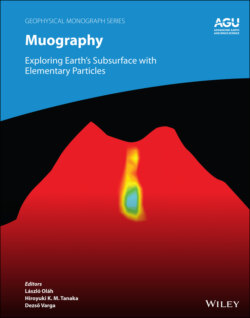Читать книгу Muography - Группа авторов - Страница 21
1.2.6 Muon Scattering
ОглавлениеWhen muons travel through matter, the Coulomb force between the muons and the nuclei in the medium leads to numerous small deflections in the muon trajectories. As a result, their angular distribution becomes broader as they propagate through matter. However, owing to the steep nature of the muon spectrum (Taira & Tanaka, 2010) the angular spread is suppressed to ~12 mrad, half width at half maximum after penetrating matter thicker than 500 hg/cm2, which is almost independent of the total thickness of the material that is traversed by muons. This angular spread has the effect of limiting the positioning resolution at the target, for example, 12 m at a distance of 1 km from the detector. The highly penetrating nature of high‐energy muons, coupled with their low divergence, enables the efficient muographic imaging of a distant target, making them suitable for long‐range applications.
Figure 1.1 Integrated muon flux after passing through rock with a given thickness in units of meter water equivalent (mwe). The angles are measured from the zenith.
